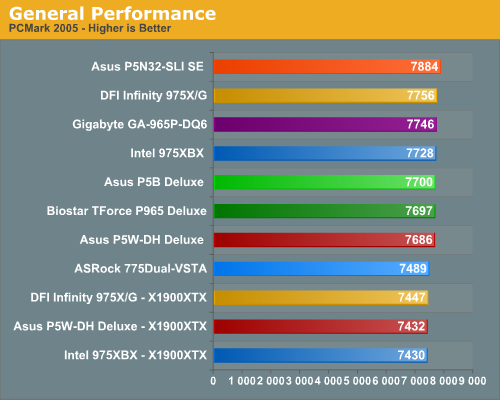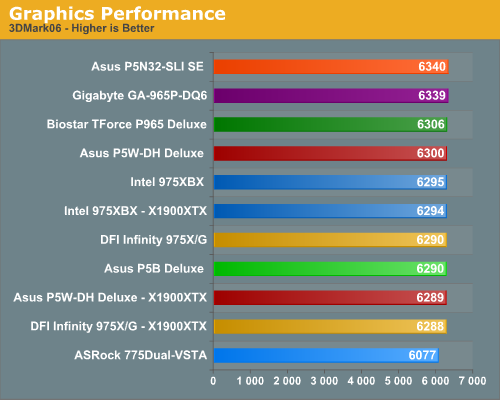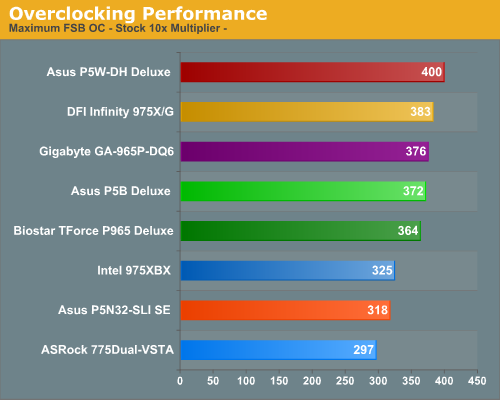Conroe Buying Guide: Feeding the Monster
by Gary Key & Wesley Fink on July 19, 2006 6:20 AM EST- Posted in
- Motherboards
General Performance
The PCMark05 benchmark, developed by Futuremark, was designed for determining overall system performance for the typical home computing user. This tool provides both system and component level benchmarking results utilizing subsets of real world applications or programs. This benchmark is useful for providing comparative results across a broad array of graphics cards, CPUs, hard disks, and memory configurations and it also includes some multithreading results. In this sense we consider the PCMark benchmark to be both synthetic and real world in nature while providing consistency in our benchmark results.

PCMark 2005 results for our test group are fairly close between the Intel chipset boards with the NVIDIA based ASUS P5N32-SLI SE taking a solid lead here due to excellent hard drive performance and multitasking scores within the benchmark. The three ATI X1900XTX equipped boards finished at the bottom of the group due to weak score results in the 2D benchmarks. Despite the close results in these tests with the Intel chipset boards, PCMark05 is still proving to be a useful overall performance benchmark. It is generally more sensitive than the older Winstones and PCMark04 to recent improvements in PC architecture.


We have replaced Winstones with 2 benchmarks that use rendering to test system performance. Cinebench 9.5 heavily stresses the CPU subsystem while performing graphics modeling and rendering. We utilize the standard benchmark demo within the program along with the default settings. Cinebench 9.5 features two different benchmarks with one test utilizing a single core and the second test showcasing the power of multiple cores in rendering the benchmark image.
While results are generally close in Cinebench, the ASUS P5N32-SLI SE tops the Dual-Core test results with the Intel 975XBX finishing a strong first in the single core tests, followed closely by the ASUS P5W-DH in both tests.
The 3DMark series of benchmarks by Futuremark are among the most widely used tools for benchmark reporting and comparisons. Although the benchmarks are very useful for providing apple to apple comparisons across a broad array of GPU and CPU configurations, they are not a substitute for actual application and gaming benchmarks. In this sense we consider the 3DMark benchmarks to be purely synthetic in nature but still valuable for providing consistent measurements of performance.

After taking a very strong first place in PCMark2005, we see the ASUS P5N32-SLI SE squeaking out a win in the 3DMark06 with an excellent performance turned in by the Gigabyte GA-965P-DQ6 for second place. The performance of the entire group was very close with the exception of the ASRock board due to its PCIe implementation (although a score over 6000 is still very respectable). The surprise was the ATI X1900XTX GPU scores as they have historically scored better in this benchmark than the NVIDIA based 7900GTX cards. We are still having conversations with ATI, but there appears to be a driver issue with the Core 2 Duo processors in our testing as the game scores will reflect the same results.
Overclocking Comparison

The overclocking capabilities we have measured thus far are with our standard E6700 CPU at a 10X multiplier. While this will not show the true FSB potential of the board, it does show a board's capability with the second highest performing Core 2 Duo and what can be expected with the fixed multiplier CPUs on average. We will be providing FSB overclocking results in our individual board reviews with the unlocked X6800. However, the only board in our testing that exceeded a 400FSB was the ASUS P5W-DH that reached 445MHz with our amazing little E6600 before running out of MCH voltage.
The NVIDIA based ASUS P5N32-SLI SE turned in a decent overclocking performance for an NVIDIA based Intel board but falls far short of the Intel chipset boards in high FSB overclocking. This situation will improve gradually over the next several months with the release of the DFI nF590 SLI board next month and then with the next true chipset revision this winter. Although the nForce4 Intel Edition board did not overclock competitively with the Intel chipsets when utilizing the FSB method, it did match the same overclocks when raising the CPU multiplier with our X6800 CPU.
The PCMark05 benchmark, developed by Futuremark, was designed for determining overall system performance for the typical home computing user. This tool provides both system and component level benchmarking results utilizing subsets of real world applications or programs. This benchmark is useful for providing comparative results across a broad array of graphics cards, CPUs, hard disks, and memory configurations and it also includes some multithreading results. In this sense we consider the PCMark benchmark to be both synthetic and real world in nature while providing consistency in our benchmark results.

PCMark 2005 results for our test group are fairly close between the Intel chipset boards with the NVIDIA based ASUS P5N32-SLI SE taking a solid lead here due to excellent hard drive performance and multitasking scores within the benchmark. The three ATI X1900XTX equipped boards finished at the bottom of the group due to weak score results in the 2D benchmarks. Despite the close results in these tests with the Intel chipset boards, PCMark05 is still proving to be a useful overall performance benchmark. It is generally more sensitive than the older Winstones and PCMark04 to recent improvements in PC architecture.


We have replaced Winstones with 2 benchmarks that use rendering to test system performance. Cinebench 9.5 heavily stresses the CPU subsystem while performing graphics modeling and rendering. We utilize the standard benchmark demo within the program along with the default settings. Cinebench 9.5 features two different benchmarks with one test utilizing a single core and the second test showcasing the power of multiple cores in rendering the benchmark image.
While results are generally close in Cinebench, the ASUS P5N32-SLI SE tops the Dual-Core test results with the Intel 975XBX finishing a strong first in the single core tests, followed closely by the ASUS P5W-DH in both tests.
The 3DMark series of benchmarks by Futuremark are among the most widely used tools for benchmark reporting and comparisons. Although the benchmarks are very useful for providing apple to apple comparisons across a broad array of GPU and CPU configurations, they are not a substitute for actual application and gaming benchmarks. In this sense we consider the 3DMark benchmarks to be purely synthetic in nature but still valuable for providing consistent measurements of performance.

After taking a very strong first place in PCMark2005, we see the ASUS P5N32-SLI SE squeaking out a win in the 3DMark06 with an excellent performance turned in by the Gigabyte GA-965P-DQ6 for second place. The performance of the entire group was very close with the exception of the ASRock board due to its PCIe implementation (although a score over 6000 is still very respectable). The surprise was the ATI X1900XTX GPU scores as they have historically scored better in this benchmark than the NVIDIA based 7900GTX cards. We are still having conversations with ATI, but there appears to be a driver issue with the Core 2 Duo processors in our testing as the game scores will reflect the same results.
Overclocking Comparison

The overclocking capabilities we have measured thus far are with our standard E6700 CPU at a 10X multiplier. While this will not show the true FSB potential of the board, it does show a board's capability with the second highest performing Core 2 Duo and what can be expected with the fixed multiplier CPUs on average. We will be providing FSB overclocking results in our individual board reviews with the unlocked X6800. However, the only board in our testing that exceeded a 400FSB was the ASUS P5W-DH that reached 445MHz with our amazing little E6600 before running out of MCH voltage.
The NVIDIA based ASUS P5N32-SLI SE turned in a decent overclocking performance for an NVIDIA based Intel board but falls far short of the Intel chipset boards in high FSB overclocking. This situation will improve gradually over the next several months with the release of the DFI nF590 SLI board next month and then with the next true chipset revision this winter. Although the nForce4 Intel Edition board did not overclock competitively with the Intel chipsets when utilizing the FSB method, it did match the same overclocks when raising the CPU multiplier with our X6800 CPU.










123 Comments
View All Comments
jonmcguffin - Friday, July 21, 2006 - link
Actually, heck, I'm not much of an overclocker at all (I know that makes me the minority here). I'm looking at the Core 2 6600 at its native 2.4Ghz, 4Mb L2 Cache & 1066Mhz BUS Speed and figure that should be seriously fine for me.In regards to memory, I'd much rather purchase 2Gig's @ $180.00 than at $450.00 and since I'm not overclocking that shouldn't be a problem. But what I would have liked to have seen in this article were value sticks rated at DDR2 800Mhz as opposed to 667Mhz. So I anxiously await a "value-ram" roundup article of some sorts to not only show us what memory modules work well in the various mobo's but also which sticks can operate at those frequencies with low timing.
Jon
Wesley Fink - Saturday, July 22, 2006 - link
The Buyers Guide shows all the Value Ram operating at DDR2-800 at 4-3-3-3 at around 2.2V. We also show the timings and voltage of the value Ram at 667, 533, and 400, in addition to 800.jonmcguffin - Sunday, July 23, 2006 - link
Correct, but the ratings from the manufacture don't have those memory module's spec'd at DDR2-800. You were overclocking them essentially. Check out theCorsair 2Gb TWIN2X2048-6400 DDR2-800Mhz set. These two sticks are rated at DDR2, sell for $160 - $170 and run at 5-5-5-12-T1 timings at 1.9V.
I would consider these a good starting point. Again, I'm not necessarily into running anything beyond the manufacture's claims, but for this price, it would seem these memory modules would fit the bill for a lot of users out there.
Jon
Gary Key - Friday, July 21, 2006 - link
All,I received a new beta bios from Abit today. I will be testing it later and will provide a quick update before we publish our final review on the board. Abit has spent considerable time this week testing this bios before release to us and hopefully it will fully address the memory setting issue we first reported in our preview issue.
perpetualdark - Friday, July 21, 2006 - link
I dont know where you priced your motherboards for this review, but I purchased the DFI 975x/g on july 18th from zipzoomfly for $187. It shipped the next day and I should see it today or Monday.Given that the DFI board is available for $62 less than your article shows, I think I made a good choice, since I dont need to overclock or run any high end graphics.
Now I just need to get my hands on a cpu. This is for a work computer, but after things settle out around octoberish I will upgrade my home gaming setup with the conroe. I am playing titan quest right now, and even with a geforce 7950 the game hitches quite a bit in certain areas at most resolutions.. I figure increasing the cpu power will help substantially, at least thats my excuse for upgrading.
Gary Key - Friday, July 21, 2006 - link
The price was taken at the time the article written (17th) based on pricing from three different suppliers that had the board in stock. Now that ZipZoomFly (would assume others shortly) has it in stock at a price point (slightly below) that we had discussed with DFI I will update our article. The 7950GTX has not been qualified on this board yet so performance issues could occur since the required bios optimizations between the board and card are not completed. We really like this motherboard and for the $187 price, it is a great value now and one that should be seriously considered for purchase by early Core 2 Duo buyers. Although, we expected more in the way of overclocking, a very solild 375FSB is nothing to sneeze at and stock performance is excellent. Thank you for the price update! :)Gary Key - Friday, July 21, 2006 - link
Where is the edit button?a very solid.....
Roy2001 - Thursday, July 20, 2006 - link
I am looking for OC a E6600 with 4MB cache to 4Ghz with minimum budget and I never OC my system. So I don't know which value board/RAM would meet the target. I don't care about timing/latency. I would like to see anandtech to publish guides for high performance OCers and value OCers and help us to reach max speed.In addition, I can pickup DDR2-800 RAM priced similar to those 667 RAMs, I don't understand why they are not included in review?
Thanks.
Gary Key - Thursday, July 20, 2006 - link
We will have additional guides in the near future. As for the DDR2-800 memory, we will be looking those modules in a mid-range section and a couple of the lower end that we have tested did not do any better than the high end DDR2-533/667 from a timing viewpoint or a high speed. Getting a E6600 to 4GHz is not that easy with a minimum budget but your suggestions are noted for the next guide. Thank you for the comments. :)Roy2001 - Friday, July 21, 2006 - link
I know minimum budget system won't be easy to hit 4Ghz speed. I am not too sensitive to the money, but I just don't want to spend $450 for best RAM while I can hit 4Ghz with $150 RAM. Same thing happens to motherboard. I don't care 1394 port, optical port, as long as it is stable @4Ghz, I just pick the lowest priced although I can afford a $250 mother board. Hope that helps as I think I am not alone. Thanks for your hard work!